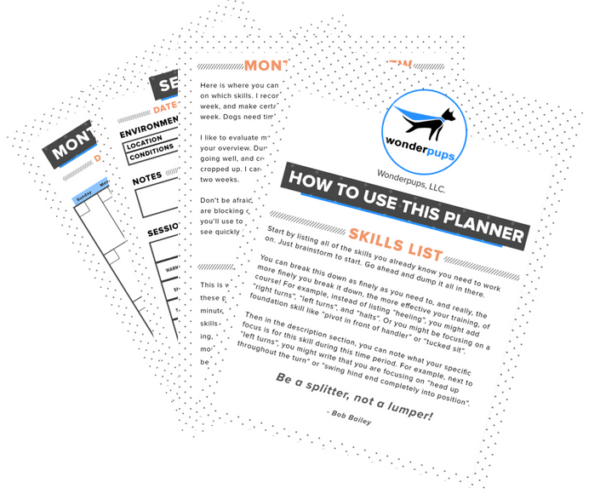But wait! I thought luring was “illegal” for clicker trainers? HOW IS THIS POSSIBLE??
Whoa, whoa, whoa… Hold your horses (or llamas or whatever).
Luring, or putting a treat in front of the animal’s nose to guide a movement or behavior, is a tool and it has it’s strengths and weaknesses. I’m comfortable admitting I do use luring to jump start certain behaviors, and it can work just fine (used appropriately).
But for the most part, I find myself using less and less luring to teach new behaviors, because I’m getting better at finding ways to split the skills needed more effectively. And that results in as good, and frequently better results than I would have previously gotten with luring, and without any of the drawbacks.
However, I frequently use and recommend luring the dog in the spaces BETWEEN training. That sounds weird, but I’m not luring the behavior itself, whatever it is that I am training, but instead I’m using the lure to *manage* my dog to prevent undesired things from occurring when I’m not focused on the goal behavior. It’s a fabulous tool in this context, because it really lets us (and the dog) concentrate on the goal behavior.
We call this excellent tool a “treat magnet”, a name I first heard from Emelie Johnson Vegh and Eva Bertilsson’s book Agility Right From the Start (great training book, highly recommend), and it was one of those simple, yet elegant, techniques that make you want to just bop yourself on the head. #duh!
The treat magnet is crazy useful any time you need to transport your dog through space:
- from his crate to the training area
- to the starting point of a sequence
- moving through a crowd
- into position to begin a new rep
The important thing to remember is that while I’m treat magneting (yes, that’s a word Siri) my dog, he’s not actually learning anything. But I am keeping him connected and happy, and preventing anything undesirable from happening. It helps me maintain my “training bubble” and keep my session clean of extraneous junk.
Below is an example of one of the places I commonly make use of a treat magnet. I’m setting my dog up to work on his A-frame behavior. The focus of my session is on him hitting the contact zone, so that is the behavior I want to cue and reinforce. But to reset after each repetition, I have to move him 3247 miles back to the other side of the equipment. That could result in a GIANT gap, dropping my rate of reinforcement (ROR) to almost nothing, and where teenage terrier might decide to go sightseeing and discover his own source of reinforcement in the environment.
In fact, if you do a little math here, you’ll see that it takes me at least 9 seconds just to walk back to our starting point, and then some amount of time to get him set and position myself in the relevant location… resulting in a ROR of something like a treat every 17-20 seconds… waaaaaay too low to keep this little dude in the game.
I could cue him to heel with me back to the starting point, but then I’d be stuck having to decide if I want to maintain criteria on his heel position, or risk having that (very expensive) behavior degrade. And heeling isn’t the focus of this session. A-frame is. So instead, I can use the treat magnet to pick him up directly from the Pet Tutor, and transport him back to the other side of the A-frame.
During that 9 seconds of ridiculously slow walking (on a terrier scale), he’s nibbling the treat in my hand and quite happy to do so. When we get where we’re going, he gets that treat. And then we are all set to do the next rep.
In that time, I’m also free to think about what happened in the last rep, and consider my criteria for the next one. I can even talk to my friend, who is videotaping for me, and generally rest my brain for a second. All without having to worry about my dog disconnecting and going off marauding about her yard, peeing on who knows what, and possibly finding a hole in her fence.
It’s always easier to keep a dog’s attention than get a dog’s attention. And using the treat magnet is a simple way to keep my dog engaged throughout the session, so that I am less likely to be stuck having to refocus him between reps.
To teach the treat magnet:
Objective: Dog maintains contact with your hand holding the treat, nibbling the treat, and following your hand as you move
1. Hold a treat between your thumb and the flat part of your first two fingers. (This gives your dog a flat surface to press against, and protects the sensitive tips of your fingers.)
2. Present your hand to the dog, palm facing his nose.
3. When the dog contacts your hand, move your thumb to uncover the treat and let the dog take it.
4. Repeat, gradually moving your hand a few inches at a time, releasing the treat to the dog when he maintains contact with your hand.
5. Keep adding more duration and distance to your treat magnet. To move longer distances (like clear across an agility field), you may need to reinforce several times by letting the dog get the treat, and starting a new treat magnet from there.
6. Practice in different environments and around distractions.
Most dogs pick this up really quickly… following food is something they are already pretty good at! The hard part is remembering to use it in your sessions. But once you are in the habit of treat magneting (still a word!), you won’t know how you ever trained without it!
